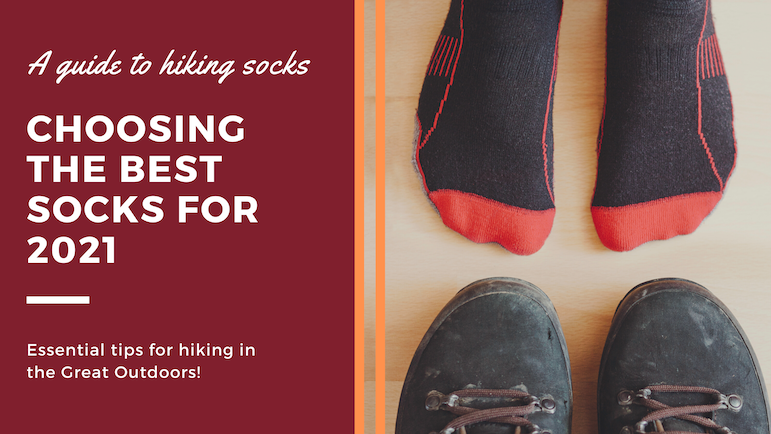Choosing The Best Hiking Socks For 2021
Hiking in the Great Outdoors is a fun, relaxing and fulfilling experience, but it can be annoying to end the day with sore and blistered feet. It’s something most hikers will experience at one point, and for some people it can be enough to not hike altogether.
Luckily there is a very simple solution to this issue:
Why Hiking Socks?
To understand why hiking socks are so effective in reducing blisters and foot soreness, we first need to understand what causes these conditions.
When hiking over a long distance, it is perfectly normal for your feet to heat up and sweat slightly. The humidity that builds up around the foot needs to be evacuated, and with normal socks made out cotton this doesn’t happen fast enough because the material takes so long to dry.
The moisture trapped inside the shoe results in the skin becoming more sensitive. The socks become humid, heavier and loose cushioning, increasing the friction with the skin, which in turn forms blisters as a defence mechanism.
Hiking socks are different because they are made specifically to evacuate moisture and dry as fast as possible. They also provide extra cushioning for the foot in the most sensitive spots, such as the heel, the arch and the toes.
Which Type Of Sock?
The level of cushioning and drying speed depends on what the thickness of the socks is and what they are made of.
For the most part you’ll find them in a combination of three materials:
Synthetic:
Synthetic socks dry the fastest. They are very breathable, which makes them ideal for very warm climates.
The disadvantage is that after usually just a day of use the fabric tends to harden, quickly loosing most of its cushioning power. Your socks and feet will also smell terrible, which is fine if you’re alone, but bad news if you need to share a tent with someone.
If you’re headed for very warm climates and have plenty of spares or can clean them every day, synthetic socks are ideal.
Wool / Synthetic:
Socks made of a blend of wool and synthetic fabrics are our go-to for most trips. They dry very fast but are slightly less breathable than synthetic socks.
Their greatest advantage is the anti-bacterial properties of wool, meaning they will remain comfortable and smell-free for at least a few days!
We usually bring one pair for every three days we expect to be out on our travels. This makes them ideal for long hikes in every type of climate.
Cotton / Synthetic:
These socks are not as common and are more limited in use, as they are breathable and comfortable but very slow to dry.
These are only good for short to medium length hikes in very dry climates, as this will help them dry a little faster.
Whatever you do, remember to absolutely avoid 100% cotton socks for that same reason, they will take even longer to dry and are a sure way to end up with blistered feet!
Which Size?
As with all footwear, sizing is extremely important.
With socks, it’s very easy. Most brands don’t make models in a single size (like a 38 or a 5 UK), but rather in ranges that go from extra small all the way to extra large. Each range can fit two to three sizes, like a 35 to 38. This makes it much easier to find the right one for you.
But what to do if you happen to be in between sizes?
Let’s say for example that your foot measures 39/½. The socks you want are an M sized 37 to 39, which means the next size is an L 40 to 42. Which one should you choose?
You might be tempted to go for the large, but the best choice would actually be to undersize and go for the medium. Unlike shoes, socks are best if exactly sized or slightly smaller, as they will easily stretch enough to cover a half-size difference.
If you choose a size that is too big the socks might create folds under your foot, and increase the chance of blisters!
Which brands should you consider?
Because we prefer to travel light and without carrying too much stuff, we love to use socks made of a blend of wool and synthetic fabrics, as they last much longer without having to be washed.
Our top brand for this type of socks is without a doubt Bridgedale. I can’t praise the quality enough. All the pairs we have owned are ridiculously comfortable, and have held up without any difficulty after years of heavy use at work, during our travels and on the trail.
If instead you want something synthetic, the best brand I can suggest has to be Falke. We don’t use them as often because their choice of wool blends is fairly limited, but their socks are extremely high quality, light and breathable, perfect for warmer climates!
A Few Extra Tips:
If your wool socks are itchy, give them a quick machine wash at 30°C.
If you have access to clean bodies of water and streams during your hike and the weather is nice, wash your synthetic socks and let them hang from your backpack while you walk. If it’s sunny they should only take a few hours to dry!
If even with the right hiking socks you’re feet are still too humid, rub them with talc or baby powder. It will absorb the excessive moisture and keep them dry and blister free!
If you’re cold, wear thick socks, not two pairs on top of each other!
Using two pairs will cause the one closer to your foot to retain moisture, and by know we all know what that means. You can also use liners, very thin socks that are made to be worn under your main pair to either aid in evacuating moisture or to keep you warmer.
Always make sure that the the sock covers every part of your foot that comes into contact with your footwear. Especially with boots, make sure that your ankles and thighs are covered as to avoid friction between the interior lining and your skin.
Pick the right socks and you very likely won’t have to deal with blisters again, I can tell you by experience.
Enjoying the outdoors needs to be an enjoyable experience, not something that causes you pain and discomfort.
So, if you’re still on the edge about giving hiking a shot, I hope this article gives you the motivation you were looking for!
I’ll see you on the trail and until next time this is Luca, signing off.
Other articles you might enjoy:
𝘿𝙞𝙙 𝙮𝙤𝙪 𝙚𝙣𝙟𝙤𝙮 𝙩𝙝𝙞𝙨 𝙖𝙧𝙩𝙞𝙘𝙡𝙚 ?
𝘠𝘰𝘶 𝘤𝘢𝘯 𝘴𝘢𝘷𝘦 𝘰𝘳 𝘱𝘪𝘯 𝘵𝘩𝘪𝘴 𝘪𝘮𝘢𝘨𝘦 𝘴𝘰 𝘵𝘩𝘢𝘵 𝘺𝘰𝘶 𝘤𝘢𝘯 𝘢𝘭𝘸𝘢𝘺𝘴 𝘭𝘰𝘰𝘬 𝘣𝘢𝘤𝘬 𝘰𝘯 𝘵𝘩𝘦𝘴𝘦 𝘵𝘪𝘱𝘴 !










